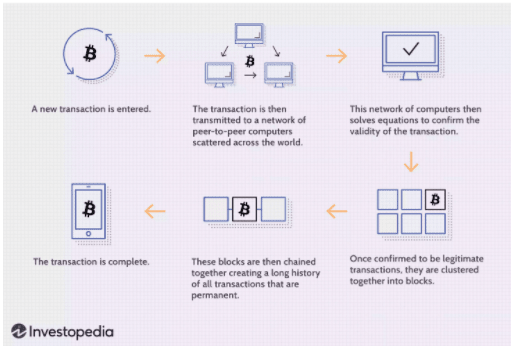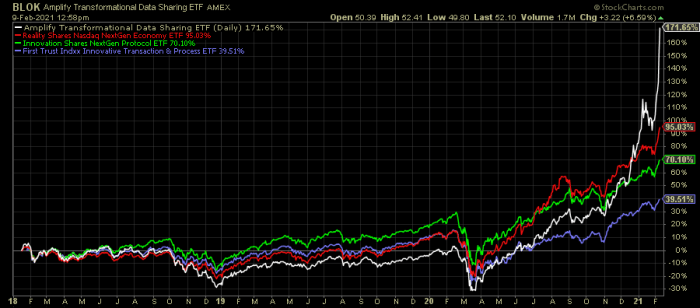With bitcoin prices soaring, ethereum producing even bigger gains and dogecoin becoming Elon Musk’s digital coin of choice, the spotlight on cryptocurrencies have perhaps never been higher. Whether these digital assets ever become a true alternative or even replacement for traditional assets, such as gold or the dollar, will be argued for ages, but there’s little question that it’s become a popular part of the financial system.
Underlying bitcoin is blockchain, the record-keeping technology that keeps cryptocurrencies running. The first blockchain ETFs showed up in early 2018 and have thus far been met with only tepid interest. The big four blockchain ETFs (which all happened to debut within about two weeks of each other) still only have a combined $1 billion in assets, a relatively modest amount by ETF industry standards and not nearly keeping up with the interest in bitcoin, ethereum and other currencies.
These ETFs, however, have delivered some impressive returns lately and the renewed focus on cryptocurrencies could mean big things for this group over the next year.
What Is Blockchain?
Without diving too far into the weeds, blockchain, at its core, is a transactional record keeping system. According to Investopedia:
A blockchain collects information together in groups, also known as blocks, that hold sets of information. Blocks have certain storage capacities and, when filled, are chained onto the previously filled block, forming a chain of data known as the “blockchain.” All new information that follows that freshly added block is compiled into a newly formed block that will then also be added to the chain once filled.
With bitcoin ETFs getting rejected by the SEC (although there is some progress being made), blockchain ETFs might be the next best thing for cryptocurrency-like exposure. As I mentioned earlier, there are 4 major blockchain ETFs out there today, but they are very different from each other. Each approaches blockchain “exposure” in different ways and this is a perfect example of why it’s important to know what’s under the hood.
It’s also interesting to note that you’ll not find the word “blockchain” in the name of any of these ETFs. That’s not an accident. In fact, the SEC mandated it. Back when blockchain was in its infancy, it became a red hot industry buzzword. It was the time where companies threw the word “blockchain” in their name and the stock instantly soared 500% (looking at you, Riot Blockchain!).
The SEC, not wanting to create a similar frenzy that saw investors piling into anything with the word “blockchain” in it and not knowing what they were actually buying, required ETF filings to not include the word in their names. To their credit, ETF issuers got pretty crafty with their names and tickers, but it was undoubtedly a big factor in why these funds have failed to get bigger.
Let’s start with the biggest ETF of the group.
Amplify Transformational Data Sharing ETF (BLOK)
BLOK is the original blockchain ETF and, to date, the most successful. Its $600+ million in assets accounts for roughly 2/3 of all assets in blockchain ETFs. Its 170% total return since inception just over three years ago nearly doubles that of its next closest peer.
BLOK is also the only actively-managed ETF of the bunch. That’s an important distinction when operating in such a rapidly changing space. I usually argue that, all things being equal, a low cost index fund is the way to go, but there are exceptions. One is when the sector is evolving so rapidly that the fund’s managers need to have the ability to remain nimble to respond to changes that are happening. Index funds, which typically only rebalance every 3-6 months, don’t have that ability and it can cause them to lag. In these situations, paying more for an active fund can actually make more sense.
BLOK requires that its components be “actively involved in the development and utilization of transformational data sharing technologies”. In order to qualify, a company must fulfill at least one of the following requirements.
- Actively engaging in the research and development, proof-of-concept testing, and/or implementation of transformational data sharing technology.
- Profiting from the demand for transformational data sharing applications such as transaction data, cryptocurrency and supply chain data.
- Partnering with and/or directly investing in companies that are actively engaged in the development and/or use of transformational data sharing technology.
- Acting as a member of multiple consortiums or groups dedicated to the exploration of transformational data sharing technology use.
It’s worth noting that BLOK has a 3% position in the Grayscale Bitcoin Trust (GBTC), making it one of the only ETFs in the marketplace to have direct bitcoin exposure. Its expense ratio of 0.70% is also right in line with those of its blockchain index fund counterparts, so you wouldn’t even be paying a premium price for active management.
Siren Nasdaq NextGen Economy ETF (BLCN)
Formerly the Reality Shares Nasdaq NextGen Economy ETF, BLCN tracks the Siren NASDAQ Blockchain Economy Index, which follows companies that are committing material resources to developing, researching, supporting, innovating or utilizing blockchain technology for their use or for use by others.
BLCN is unique in that it assigns each potential fund component with a Blockchain Score, which is a proprietary ranking system developed to identify those companies expected to benefit most (e.g., from increased economic profit, operational efficiencies or transformational business practices) from blockchain technology. The 50 to 100 companies with the highest Blockchain Scores make the cut with higher scores receiving greater weighting in the portfolio.
With so few companies deriving a significant part of their revenues from blockchain, I like the way that BLCN tries to identify and overweight those businesses with greater exposure to the space. It’s a better way to do business than just including companies with any exposure to blockchain.
First Trust Indxx Innovative Transaction & Process ETF (LEGR)
LEGR also takes the approach of targeting companies actively involved in blockchain development, but uses a different approach to focusing on the most heavily exposed names.
Eligible securities are classified into the following three categories:
- Tier One: Active Enablers – Companies actively developing blockchain technology products or systems for their own internal use and for the sale and support of other companies, companies that are direct service providers for blockchain technology or companies that have business models that rely on delivering products or services that use blockchain technology. Companies in this category are assigned a score of 1.
- Tier Two: Active Users – Companies that are using blockchain technology that is generally supported by an Active Enabler or have at least one use or test case of using blockchain technology. Companies in this category are assigned a score of 2.
- Tier Three: Active Explorers – Companies that have publicly disclosed that they are active in exploring the incorporation of blockchain technology into their business or have a press release on their website or a news article stating that they have started working on the blockchain technology space. Companies in this category are assigned a score of 3.
Companies with a score of 1 or 2 are selected for the index and weighted with Active Enablers receiving 50% and Active Users receiving 50%. The selected companies are weighted equally within each category. No more than 100 names will make the index.
Like BLCN, this fund appropriately gives greater weights to those companies with more direct exposure to the space, while staying away from companies which have yet to demonstrate that they’ve actually committed material resources to blockchain development.
Capital Link NextGen Protocol ETF (KOIN)
I’ll just come right out and say it. I don’t like this fund at all. KOIN is a prime example of a fund that casts too wide of a net with the end result being a portfolio that doesn’t accomplish what it should.
KOIN starts with some similarities to the other funds in that it tries to bucket companies into categories, such as enablers, providers and users, but then makes a key mistake, in my opinion, about how the final portfolio is constructed. It market-cap weights the fund.
The issuer even acknowledges the issue in its fund literature.
“The index may include equity securities of operating companies that focus on or have exposure to a wide variety of industries, and the economic fortunes of companies eligible for inclusion in the index may have minimal ties to blockchain.”
As a result, the fund’s top 10 holdings include names, such as Amazon, Baidu, PayPal, Mastercard, Visa and Microsoft. How much blockchain exposure do you think you’re really getting with KOIN? Almost none. This is purely a vanilla large-cap growth ETF more than anything.
Conclusion
BLOK is my favorite ETF in this group based primarily on its actively-managed nature. I think that’s essential if you’re looking to invest in a rapidly changing space. The fund’s results have born that out as well.
It’s interesting to note that BLOK was actually the worst performer of the group at the bottom of the COVID bear market, but is now easily the best. Other funds have produced more mixed results, but BLOK is the only one that’s managed to top the Nasdaq 100 index since inception.
I would say that BLCN and LEGR are perfectly acceptable alternatives as well. Their strategies of tiering companies by exposure and overweighting those whose businesses are more dedicated to blockchain are easily defensible.
I would definitely avoid KOIN. Not only does it not provide any real exposure to blockchain development, it’s the most expensive fund of the group by a fair amount.
Also read:
Fidelity Launches Magellan ETF
4 ETFs That Got Swept Up In The GameStop Frenzy
Marijuana ETF Up 65% YTD; Industry Conditions Keep Improving
The Top Performing ARK ETF Of 2021 Isn’t The One You Think
25 Top Performing ETFs In January
What Might The New ARK Space Exploration ETF Look Like?
MJ vs. YOLO: Which Cannabis ETF Should You Choose?
6 Vanguard ETFs That Fit In Any Retirement Portfolio



